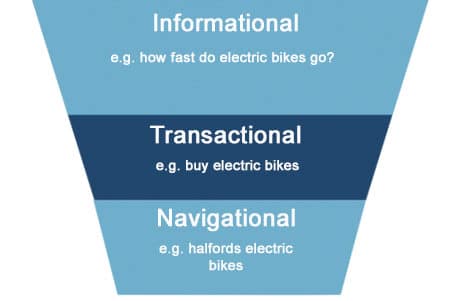Keyword research is arguably the most important aspect of your blogging strategy. When done correctly, your keyword research will help you decide what to write about, who you’re targeting, and how your competitors are faring. But most importantly, the right keywords will help you rank higher in search and drive money-making traffic to your blog.
Sounds hard, right?
Here’s the thing: blogging is a full-time job, whether you’re trying to make it the focus of your business or simply using it to support your business. But it’s importance can’t be denied: Studies show that 77% of internet users read blogs, while businesses with blogs receive 97% more links to their business than those without.
Hands down: blogging is the lifeblood to any business with an online presence, and you can maximize every post by doing keyword research that will reach more people and get you noticed.
Today I’m sharing the exact methods I use to perform strategic keyword research. The steps I’m going to show you has earned me hundreds of thousands of blog visitors that have high intent and relevancy to the content I offer.
Let’s jump in!
What is Keyword Research, Exactly?
In case you’re not familiar with the basics, keywords refer to the terms that people type into the search bar to locate content. For example, if I wanted to find a bookstore in Prague, then I might type in “Prague bookstores” into Google to see what pops up: Prague bookstores would be my keyword in this case.
Google (or whatever search engine you prefer to use) will match relevant results to my search query. Content that contains my keyword Prague bookstores are more likely to rank higher on the results page.
Think about it this way: Google is first and foremost an advertising platform. Their goal is to give their users the most helpful, relevant results possible, which is why they designed a complex algorithm that gauges content quality and relevancy. It relies on keywords (among other indicators) to understand what your content is about and decide how and when to display it to users.
Therefore, keyword research is the process of figuring out the best keywords to include in your content. These terms aren’t selected at random, but rather discovered through methodical processes (which I’m about to discuss) to understand what users are searching for, what words your competitors are ranking for, and your likelihood to rank well for those terms.
When performed correctly, your keyword research will be able to answer pressing questions like
- How people are searching for this keyword each month?
- How hard will it be to rank for this keyword?
- What are some keywords related to this term that I can use to strengthen the content?
- What other websites are ranking for this keyword?
Whether you need topic ideas or simply want to maximize your blog post, keyword research is a valuable place to start.
Why is Keyword Research Important?
Still not convinced that keyword research is the way to go? These blogging stats and facts might change your mind:
- Google’s organic search accounts for more than 94% of ALL internet traffic.
- The first result on Google gets at least 33% of the clicks.
- The first page of results on Google gets more than 90% of all clicks.
- Organic search drives more than half of all web traffic.
- Keyword research helps improve rankings, which is essential for getting organic traffic. Or in other words, traffic that you DON’T have to pay for via ads!
Keyword research is the foundation for an SEO-friendly blog post (and website at large). It’s pure, simple data that help you learn what’s trending in your niche and show you what kind of competition you’re up against. By seeing the data, you can better prepare yourself to deliver the high-value content your readers expect.
Best Keyword Research Tools to Use
I mentioned earlier that keywords aren’t just chosen at random. So how do you discover the best keywords for your blogging strategy?
Here are a few keyword research tools I’ve used and recommend. Some are free, some are pricey, but each one can help you find quality keywords to include in your strategy. Here they are, in no particular order:
Ahrefs
Ahrefs is an expensive tool, starting at about $1,000 per user per year, but those who are willing to shell out big bucks will agree it’s worth it. It’s packed with rich, easy-to-use features that streamline keyword research and backlink analysis (an important part of doing recon on your competitors).
SEMRush
Similar in size and scope to Ahrefs, SEMRush’s biggest strength is in its competitor research. Just enter a competitor’s URL and see the exact keywords they’re ranking for (and where they rank on results pages!).
Moz
Moz offers free and paid keyword research, which depends on how much you use the tool each month. You can search for keywords by copying and pasting a URL or keyword into its search bar. You can also download the Moz toolbar that will analyze competitor pages at a glance.
UberSuggest
Ubersuggest is a free keyword tool that suggests additional keywords based on your search. The data comes straight from Google itself, so you can trust its accuracy and relevancy.
Choosing Keywords Based on Search Intent
Before you start plugging in URLs and pulling keywords, it’s important to understand what a great keyword looks like. Keywords can take on many forms and meanings, some of which aren’t going to do you any favors in the SEO department.
Think about your own search habits: you use search engines like Google to find answers to a variety of questions or needs. For example, one day you might type in fried chicken to find a recipe to make at home, while another day you might type in fried chicken to find a place near you that sells fried chicken.
Notice how these are the exact same terms with different intentions. But if I just gave you the term fried chicken without any explanation, you could take that term to mean a variety of different things, right?
That’s why user intent is everything in keyword research. You need to get inside the searcher’s mind to find out why a particular term is being searched.
There are four main reasons why people use search engines like Google, and the more you can dial in on these intentions, the better choices you can make when selecting keywords for your audience and attract the right type of visitors.

Informational Intent
The most common reason people use search engines is to find information. This is a promising category for bloggers to tap into, given that we thrive at giving out advice, details, and direction for people looking for information in our area of expertise.
This post is a prime example: I’m sharing information about how to do keyword research that will improve your blog traffic.
Informational searches usually result in some form of online tutorial, infographic, article, e-book, video, or other type of content that provides solutions to the topic in question.
Whatever the subject, you should leave your readers feeling fulfilled with having read your content.
Navigational Intent
How many times have you consulted Google to find a specific store website? Users could type the URL into their address bar directly, but many will go to Google if they can’t remember the exact URL.
In other words, these users already know the website or web page they want to go to. They just need a little help getting there.
Here are some examples of navigational search:
- Squarespace website creator
- WordPress
- MSN
- Order Walgreens photos
Each of the above indicate the desire to go to a specific web page or website. This, of course, means you should steer clear of navigational search intentions because people are clearly trying to go elsewhere.
Transactional Intent
Transactional intent refers to searches with the intention to buy something. Chances are, the user has already done their homework and now they’re ready to purchase.
Some examples include:
- Weebly website plans
- Ahrefs pricing
- Flights from New York to Chicago
If you’re selling a product via your blog, transactional keywords can add major value to your content. Essentially, you’re attracting people who are in buying mode and may be willing to convert on the spot if you can present your content at the right time.
Commercial Research
Commercial research intent is similar to transactional intent, with the exception that users are still in the research phase. They’re looking for solutions and might purchase once they narrow down their results, but right now they’re comparing products and features and exploring their options.
Some examples of commercial research intent include:
- Best keyword research tools
- Online courses for freelancers
- Best cleaning services near me
Keep in mind there is some overlap between these categories, but each bring something unique to your keyword research. You’ll want to try to avoid navigational intended keywords and focus primarily on informational intent, and if applicable, transactional and commercial (for monetized blogs).
Discovering Your Current Ranking Keywords
If you are starting a new blog or your blog hasn’t been around for more than a few months, this section will apply to you in the future. For those of you with established blogs, lean in closely:
It’s important to understand the keywords you’re already ranking for. First of all, it’s an indication of what you’re doing well and can show you how effective those keywords are in your strategy. It’s equally important to measure your progress over time to see how many keywords you’re adding to your collection.
Go to your Google Analytics dashboard to view your list of keywords. Alternatively, you can copy your website or blog URL into Ahrefs and get a list of your keywords.
In addition, you can use Google Search Console to dial in on the keywords you’re ranking for that are working for you. For example, you can go to Search Results > Open Report to view the queries that are getting the most response.
This small but powerful part is essential to your strategy. You need to know where you already stand so you can choose the best path forward. And I always recommend consulting data to drive this process versus going by hunches or vibes.
Plant Your Seed Keywords First
Now I’m diving into the strategy development part of keyword research. There are a lot of moving parts to the process, and it’s best to take it step by step to ensure you don’t overlook any opportunities.
If you’ve already chosen a niche for your blog, you’ll want to look for keywords that best complement that niche. These are seed keywords that represent the broad purpose of your blog.
For example, let’s say your blog focuses on healthy eating. Your seed keywords might be any of the following:
- Healthy meals
- Clean eating
- Organic foods
- Healthy eating habits
You can probably add to this list, but you get the idea. These seed keywords are the overarching categories that will help you develop content topics. Your blog posts will fall into at least one of these groups.
Now, think about your own blog. What are the main categories you will cover? Make a list, and check it twice. Those are your seed keywords.
Niche Down to Find Long-Tail and Medium-Tail Keywords
I’m going to throw two more terms into our keyword mix: long-tail keywords and medium-tail keywords.
If you look at the above examples of seed keywords, you’ll see that each of them are short and to the point. But realize, too, that short can also be broad. Going back to our fried chicken example, short keywords like these aren’t always indicative of user intent. Even if fried chicken has a high search volume, it’s still not necessarily the best keyword to try to compete for.
That’s why it’s important to take the time to find long-tail and medium-tail keywords that are more detailed and specific – even if the search volume is lower than a shorter keyword.
Let’s say you’re writing a blog about painting. Trying to rank for the word “painting” is going to be an uphill battle. For starters, it’s not specific enough. Plus, you’ll likely have tons of competition (artists, paint shops, paint manufacturers, home improvement stores, the list goes on).
Studies show that half of all search queries are four words or longer. Or in other terms, half of all searchers are looking for something specific. I love Ahrefs because I can filter my results based on the number of words in a keyword.
Medium- and long-tail keywords adds greater depth to your search term. Going back to our example on painting, a long-tail keyword might be “best painting techniques for beginners” or “best brands or acrylic paint” or something along those lines. See the difference?
Now I’ve taken the concept of painting and added more definition to it. Also know that these terms are most likely targeting artists or hobbyists who like to paint versus a homeowner who needs to paint a room in their house.
This approach will not only help your content rank higher and faster, but will also give you a better chance of attracting the right audience. This is one of those cases where less is more — these terms might not have as high of a search volume as a shorter word, but they’re likely to bring higher quality traffic.
Look for Keywords with High Volume and Low Competition
Aside from the length of the keyword, your keyword research tools should also give you two important pieces of data: search volume and difficulty.
Search volume refers to the number of times a particular term is searched each month. Each time a user types in a specific query into their search bar, this data is saved, stored, and analyzed by keyword tracker tools.
Difficulty refers to how hard it will be for you to rank for a particular keyword. Difficulty is ranked on a scale of 0-100, where 0 indicates that a keyword will be easy to rank for and 100 will likely be impossible.
Both of these should be taken into account when selecting your keyword. The higher the search volume and the lower the competition, the better the quality of the keyword.
So, what are the magic numbers for search volume and difficulty?
That’s largely up to you. In my experience, I choose keywords with a monthly search volume of at least 100 and a difficulty rating of no more than 30. Ideally, I like to keep my difficulty rating to 10 or under. These are the low hanging fruit of keywords and I find I can rank faster if I stick to these.
However, your Domain Authority will also factor into your ability to rank. Your Domain Authority (or DA for short) is a numeric value developed by Moz on a scale of 1-100 that indicates the quality and authority of your website. Websites that publish high-quality content and are trusted sources of information will usually have a higher DA than, say, a new blog with a small following and no backlinks.
Let’s say you have a Domain Authority of 50 and your competitor has a Domain Authority of 15, and you both choose the same keyword. You have a better chance of ranking higher for that keyword than your competitor because search engines are going to give more weight to your website than theirs.
You can download the Moz toolbar to check the DA for any website, including your own.
Analyze Your Competitors’ Keywords
I like to think of analyzing competitors’ keywords as a keyword research shortcut. You’re basically looking at their keyword data to see which ones are working and which ones you should employ in your own strategy.
The process is relatively straightforward if you’re using a keyword research tool like Moz or Ahrefs. Take a look at some of the blogs in your niche or industry that you think are doing really well. Then plug their URL into Ahrefs or another analyzing tool to see which keywords they’re ranking for (along with the keyword search volume and difficulty).
Another method is to type a keyword into Google and look at the results that populate. Those are the blogs or websites that are ranking the highest for that keyword. Grab their link and plug them into Ahrefs for more keyword inspiration.
It can be downright daunting to see a competitor’s blog post rank for dozens of keywords (and here you are, struggling to get even one). But remember the quantity isn’t synonymous with quality. A helpful approach to gauge your competitor’s success is to look at their backlink profile for a particular blog post. Again, we can call on the help of Ahrefs.
Backlinks are external sources that link to a particular piece of content. These backlinks are an authority indicator that will help you rank higher in search, especially if you’re getting high-quality sources linking to you.
So, grab their URL and paste it into a backlink checker like Moz or SEMRush. Then look at how many websites link to that content. You might be able to acquire your own backlink from that website and give your competitors a run for their money.
Bonus: finding backlinks can also guide you to potential sources for guest posting. Guests posts are an excellent way to backlink to your content and build your authority.
Doing Keyword Research by Season and Regions
If you think you can sit down one weekend and do hours of keyword research and be set for life, you’re right AND wrong. Mostly wrong.
You see, keyword popularity changes over time. Certain trends, timely events, and even the time of year can increase or decrease a keyword’s monthly search volume. It happens all the time — one day people are talking about nothing but Ebola, but weeks later they’ve lost interest and moved on to another infectious disease.
Some keyword seasonality is more obvious than others. Of course people aren’t going to be talking about Halloween at Easter. But if you want to take the guesswork out of what’s trending, use tools like Buzzsumo or Google Trends to find buzzy, in-the-moment opportunities to capitalize on keywords.
I like Google Trends because I can see where a topic is popular, not just how popular it is. This is especially helpful for local-based blogs. You can even break down your results by city, state, or metro to get the most relevant results. And it’s free to use!
Final Thoughts on Keyword Research
I’ve gone into great detail on the importance of keyword research and how to do it the right way (ahem, remember user intent is everything!), but I’m going to emphasize the tangential idea that keywords are only part of the package.
Keywords alone aren’t enough to help you rank high, especially if someone else comes along using the exact same keywords as you. Though every good blog post starts with using the right keywords, I highly recommend focusing on writing high-quality content that will address your readers’ most pressing problems.
Think about it: your keywords might be just enough to help someone find you via search, and maybe even enticing enough to make them click through. But if they land on a blog post that’s poorly written, inaccurate, unorganized, or otherwise doesn’t live up to their expectations, they’re going to bounce and probably never return. And, as you may already know, a high bounce rate doesn’t bode well for your search rankings.
Google takes a multitude of aspects into account when determining how to rank your content, including keywords, user friendliness, mobile responsiveness, bounce rate, link usage, originality, and a whole heap of other indicators. Overall, they’re looking for quality factors that will give them confidence to display you in search.
The more you practice good SEO techniques and are delivering high-value, well-written content, you’ll be able to get more mileage out of every keyword in your strategy.
And don’t forget to head back to the blog for more SEO and entrepreneurial insights.






14 Responses
I do usually do my keyword research manually but still with that my traffic only do improve a little more each time i add another blog post
Is there anyway to get a more better keywords with high search volume
Going through this blog was definitely a great help
I think this is a really great article, it was amazing
This blog is definitely helpful!
Great post! It was very useful. Thanks for sharing the post.
Very informative and helpful for us. Thanks for sharing.
Thanks for this good information.
Great post! It was very useful. Thanks for the post.
Good job, best wishes…..
A proper way of optimizing keywords is a great strategy to increase traffic. Thank you for educating us, anyway.
Such a detailed post! The examples you used to explain search intent and keyword selection were incredibly helpful. A must-read for bloggers!”